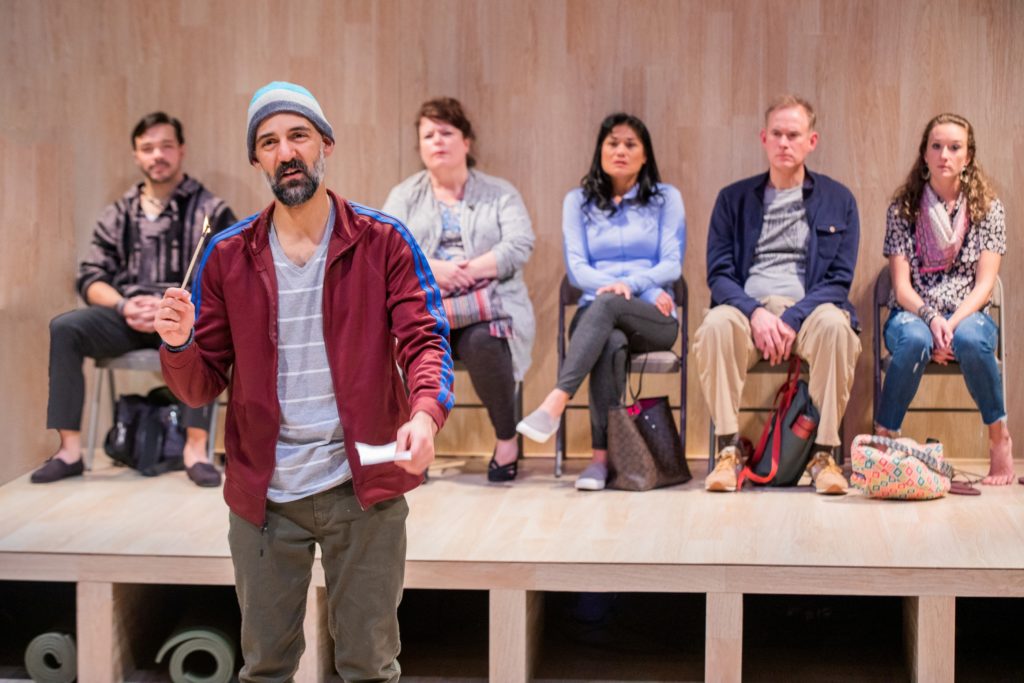Small Mouth Sounds and Not Much Dialogue Either

Photo Nile Scott Studios
Small Mouth Sounds now playing at Boston’s SpeakEasy is influenced by the personal experience of its playwright Bess Wohl who underwent the rigors of a silent retreat. The six characters that arrive at the retreat mostly alone seem to be there to change and better their lives during their five day stay. Since speech plays a relatively small role, the actors often use a form of mime to make themselves clear and the audience often needs to use guesswork to follow the action. Though the characters’ names appear in the program, they are not spoken.
Small Mouth Sounds is set in the three quarter round with a raised platform on one side where the characters often sit on folding chairs when being lectured by their guru (Marianna Bassham). The stage, covered in beige wood, suggests a yoga studio, but is also used for the outdoors. In addition, at times the lighting gives the impression of three separate rooms, each shared by two people. The characters’ yoga mats serve as beds.
Small Mouth Sounds begins with the arrival of most of the characters at the retreat somewhere in the forests of upstate New York. A pelting rainstorm contributes to the strange and unfriendly atmosphere. Much of the sound throughout the play is provided by “nature:” birds, rustling in the woods, insects, the small sounds that often pass unnoticed in everyday life.
Seated on a chair engrossed in reading material connected to the program is Jan (Barlow Adamson) who seems confused despite his efforts to understand what is happening. The next person to arrive is Rodney (Sam Simahk), a young, handsome yoga teacher involved in his own world. He immediately begins yoga practice. Ned (Nael Nacer), comes on, looks around and carefully chooses where he will sit. Judy (Celeste Oliva) and Joan (Kerry A. Dowling) enter arguing, the first words the audience hears. Unlike the others, they have brought their relationship with them. They recognize Rodney from his videos and try to engage him in conversation to no avail.
Their guru unseen by the audience introduces herself speaking through a microphone in an unpleasant voice with an odd accent. She tells them a story that some find disturbing, others confusing, before introducing the rules of the retreat, virtually all of which sound threatening. Conversation is forbidden as are smoking, consuming alcohol, cell phone use, igniting fire, eating anywhere except assigned dining areas. Nudity is permitted at the lake. She warns the characters that they will be watched throughout their stay. In the midst of the teacher’s lecture, Alicia, the sixth character makes her appearance in a tizzy calling everyone’s attention to her.
It does not take long for many of the characters to begin breaking the rules although most are there, at least in theory, to change their habits, learn who they are, and have a more fulfilling life.
The humor derives in large part from the disconnect between what they want and what they do. For example, Alicia spends a lot of time trying to reach her former boyfriend by cell phone although the break-up is a likely reason for her presence at the retreat.
On the second night Ned is chosen to answer a question which the audience is given to understand pertains to climate change. Instead he spends most of his time talking about his bad luck and confusion, the only attendee to speak at length. When the characters leave three days later most seem happier than when they arrived. At least one friendship is in the making.
Small Mouth Sounds has a talented cast which, despite the lack of dialogue, has created rich characters. M. Bevin O’Gara’s directing shows a strong understanding of Wohl’s work.
This play likely has more appeal to those who have participated in similar retreats or have friends that did. At the performance I attended, there were audience members roaring with uncontrollable laughter while others had a calmer reaction.
Small Mouth Sounds runs for 100 minutes with no intermission.
Small Mouth Sounds, produced by SpeakEasy Stage Company, plays through February 2 at the Roberts Studio Theatre in the Stanford Calderwood Pavilion at the Boston Center for the Arts at 527 Tremont Street.
Design Team:
Scenic: Cristina Todesco
Costumes: Mary Laune
Lighting: Annie Wiegand
Sound: Elizabeth Cahill